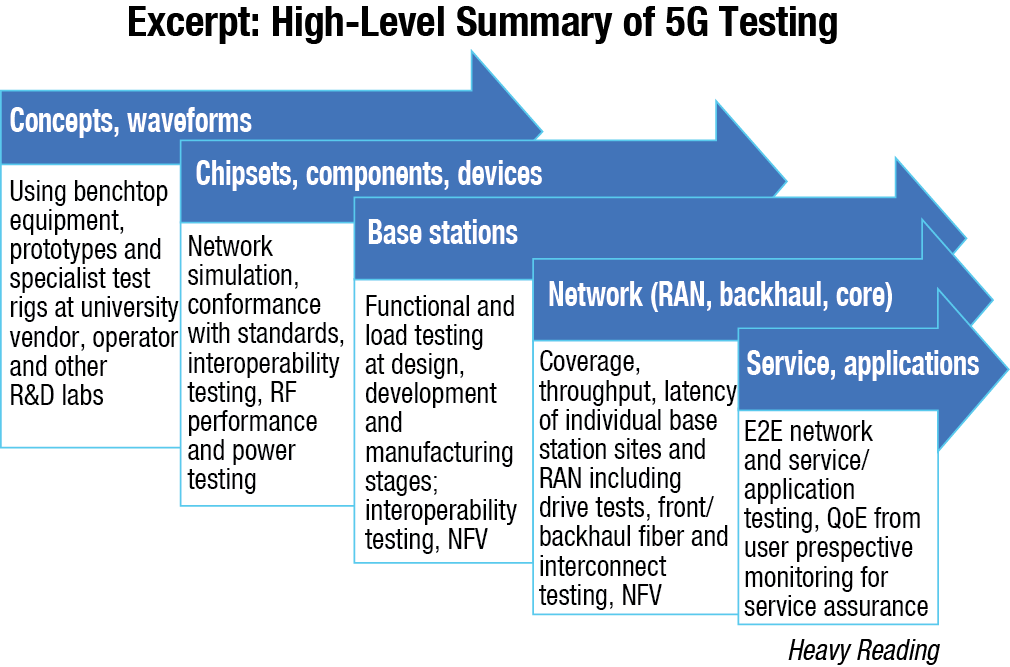CT Stories
Testing the 5G Network

5G technology is driving major changes across the entire network—from highly flexible radio access network (RAN) architecture and 3D beamforming active antennas, to software-defined network components—with stringent timing and latency requirements. The combination of new infrastructure features and functions, such as millimetre wave (mmWave) utilization and massive MIMO, provides a pathway to incredible performance enhancements. Yet these expected enhancements will rely on multiple elements performing seamlessly in tandem, introducing much greater complexity than previous generations.
Mission-critical applications will demand a network which cannot fail. Ensuring network quality will be at the core of deployment to prevent dissatisfied end users, churn, and loss of market share.
Meanwhile, conformance testing for UEs depends upon radio access, demodulation and signaling tests, as well as validation by certification organizations to ensure they comply to the latest 3GPP specifications. A number of other standards bodies also are contributing significantly in this area. ITU and the IMT group created IMT-2020, which has 3 primary use cases for 5G NR: eMBB; ultra-reliable low latency communications (URLLC); and massive machine-type communications (mMTC).
For the past few years, and into the future, T&M will play a central role as 5G networks, devices, services and business models are worked out. The long-term trends in T&M–virtualization and automation–are emphasized in 5G, as it will be essential to cost-effectively test networks and services that are supporting very many new use cases, all delivered from network slices. In fact, one could conceive of a testing slice as a way of simplifying some of the network testing that will be needed in live networks. This would require virtualized test resources, deployed where needed, and spun up or down as required.
The T&M market is enjoying a surge in 5G-related activity even though 4G network testing has not yet disappeared because 4G networks are still evolving; indeed, in some countries, new 4G networks are still being rolled out. The close relationship between 4G and 5G, in particular the use of the 4G core with 5G radio network, and the new technical challenges of testing chipsets, devices, base stations and RAN designed for mmWave spectrum, mean that T&M vendors have had to work hard alongside their NEP and operator partners to develop practical, economic testing methods. In the short term, there is still a lot of 5G work to do in the lab, on the production line and in the field. It’s a good time to be a T&M vendor. We are now at the stage where most–but not all–forms of T&M activity are taking place simultaneously, and vendors of T&M equipment are very pleased because a new generation of wireless technology brings with it new testing requirements. The Excerpt in the image summarizes at a high level the testing required as 5G moves from academic and industry research labs into live networks delivering real services. There is considerable overlap in the real world between the broad areas in the chart: components are not tested in isolation and each new release of a 5G feature involves testing in many places in the chart. However, the chart serves to structure discussion of the main issues and challenges of testing for 5G.
This 5G-fueled evolution will bring unprecedented network complexity with 20x the number of cell sites deployed and require increased deployment speeds. An efficient and automated test workflow process from the T&M vendors gives the operations teams a competitive advantage by driving team efficiency, ensuring compliance for first-time right results and accelerating time-to-revenue.
Keysight Technologies first began working on 5G in 2013; it was pre-standards, and all the work was to set up platforms for this inflection. Keysight says that its solutions have supported the development of around 75 percent of the several hundred 5G devices that have already been announced, from early in the design process to the validation and conformance phases.
Many of these solutions were developed with software intellectual property that Keysight has acquired through its purchases of Anite, AT4 Wireless, Prisma, and Ixia. Keysight has recently launched solutions including LoadCore, which simulates real-world subscriber models for a Standalone 5G Core (5GC); benchmarking tools for 5G device performance assessment before such devices go to market; a new signal analyzer with millimeter wave support, for design validation and manufacturing; plus a security operations platform and testing for validation of open Radio Access Network radios, among others.
Viavi Solutions. Since 2013, Viavi Solutions has been an early driver in 5G adoption and the vendor continues to deliver innovative and cost-effective 5G testing tools to customers. The company is a driving force in 5G, partnering with the world’s top communication providers and network equipment manufacturers since the technology’s inception. The result of that long-standing collaboration is deep expertise in test process automation that brings unparalleled efficiency for developing, enabling, assuring, and optimizing networks with speed and success in both the lab and the field. The Viavi portfolio of industry-leading 5G testing solutions includes TM500, TeraVM, T-BERD/MTS, CellAdvisor, NITRO Mobile and 3Z RF Vision brands. Viavi offers complete 5G solutions for validation, verification, and visibility.
Rohde & Schwarz has a complete T&M portfolio for wireless communications technology and secure networks. While this includes full test solutions for 5G devices and base stations, as well as for 5G mobile networks, the connectivity specialist also offers solutions for connected cars, smart factories, and 5G broadcast technology. In addition, SD-WAN and cyber-security solutions are also popular.
The 5G and wireless connectivity testing solutions address chipset vendors, mobile device OEMs, and base station manufacturers, as well as test houses and certification authorities. The focus is on 5G signaling and non-signaling testing solutions for FR1 and FR2 and for the product life cycle, starting from R&D, to acceptance and production. Its advanced mobile network testing solutions support 5G network roll-out from lab testing to field deployment. The solutions include coverage and performance testing for providing network operators, infrastructure vendors, service providers and telecoms regulators a deep insight into end-user QoE.
EXFO. As the journey to deliver the full promise of 5G began, EXFO has been supporting forward-thinking network operators and equipment vendors worldwide in their 5G trials and deployments through customized insights, methodologies and tools.
The move to 5G will radically transform networks and services, from core to edge. Virtualized network cores, leveraging SDN, NFV and network slicing. New radio technology enhancing both fixed wireless access and enhanced mobility. Broader reach with more bandwidth, lower latency and higher availability. Each of these help open the floodgates of service innovation. Having full performance visibility is key to a successful transformation. EXFO offers test and measurement solutions, service assurance solutions, analytics solutions, and simulator solutions providing the insight the network needs. As the leader in handheld optical test equipment, EXFO has the products and expertise needed to ensure the networks perform flawlessly.
Anritsu is currently at the leading edge of 5G development and deployment, providing testing and monitoring solutions across the telecom eco-system and different industry verticals related to 5G. Its test and measurement solutions cover the full range of devices, base-station and access networks, data centres and core networks, and across the full life cycle of R&D, certification, production, and installation/maintenance. The monitoring solutions for mobile networks give enhanced visibility across domains, with advanced analytics and insights into network performance.

Outlook
The key to a winning strategy, which is satisfying 5G high-bandwidth and higher cell-site density demands, is to future proof the infrastructure and be prepared to deliver flexible and agile wireless networks.
No doubt, the pandemic has injected an element of uncertainty in 5G progress. With the COVID-19 pandemic, there is an open question on how this global disruption will impact 5G adoption. We are under an unprecedented medical, economic, and political situation that is playing out around the world. This is an opportunity for the technology industry to do more to help global communities. 5G adoption can help medical, manufacturing, and financial industries with many innovations for remote, flexible communications. It can help the global economy because many of us are dealing with connectivity issues with prolonged working from home. Governments of the world may seek to accelerate 5G adoption to help fast-track the recovery process.















You must be logged in to post a comment Login